Intake Manifold Replacement Upper
Removal Procedure
Important: You do not have to remove the upper intake
manifold in order to remove the lower intake manifold.

- Remove the engine cover. Refer to
Engine Cover Replacement
.
- Remove the air cleaner assembly. Refer to
Air Cleaner Assembly Replacement
in Engine Controls.
- Disconnect the PCV tube from the air cleaner outlet duct.
- Remove the air cleaner outlet duct from the throttle body. Refer to
Air Cleaner Outlet Duct Replacement
in Engine
Controls.
- Disconnect the accelerator control cable from the throttle shaft and
the accelerator control cable bracket. Refer to
Accelerator Control Cable Replacement
in Engine Controls.
- Disconnect the cruise control cable, if equipped from the throttle shaft
and the accelerator control cable bracket. Refer to
Cruise Control Cable Replacement
in Cruise Control.
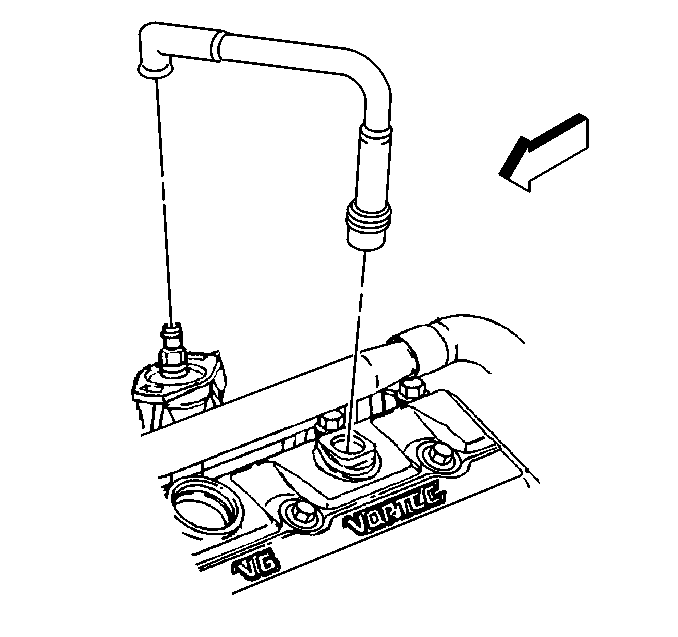
- Remove the PCV valve hose assembly from the intake manifold and the valve rocker
arm cover.
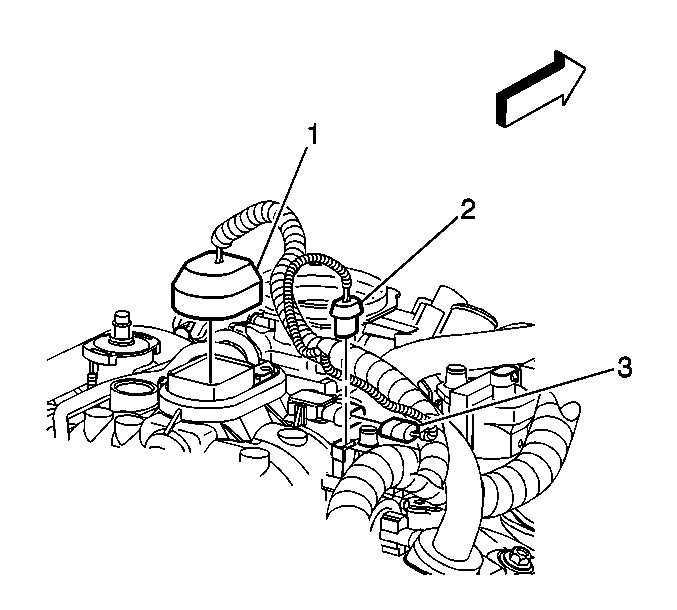
- Disconnect the following electrical connectors:
| • | The fuel meter body assembly connector (1) |
| • | The EVAP canister purge solenoid valve (2) |
| • | The manifold absolute pressure (MAP) sensor (3) |

- Disconnect the following electrical connectors:
| • | The throttle position (TP) sensor (1) |
| • | The idle air control (IAC) motor (2) |
| • | The engine coolant temperature (ECT) gauge sensor (3) |
| • | The A/C high pressure switch (4), if equipped |
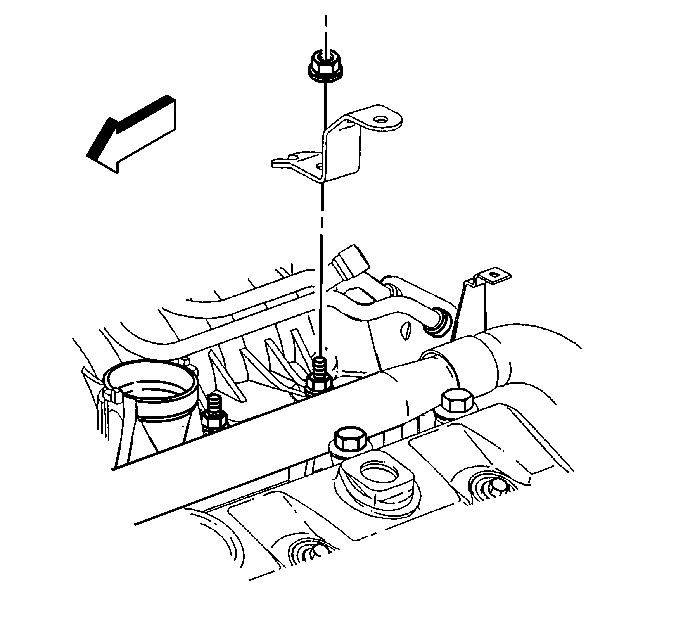
- Remove the engine wiring harness bracket
from the intake manifold stud.
- Move and secure the engine wiring harness out of the way.
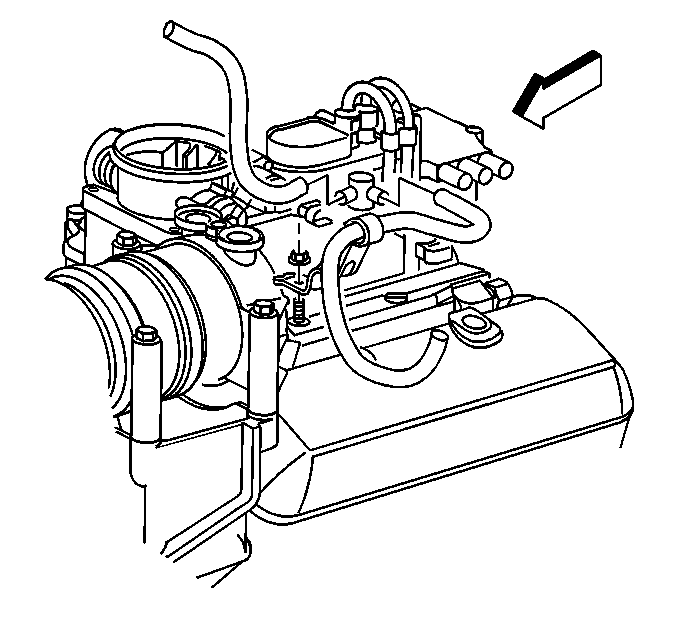
- Disconnect the A/C vacuum hose from the
intake manifold.
- Remove the power brake booster vacuum hose bracket and nut from the intake
manifold stud.
- Disconnect the power brake booster vacuum hose from the intake manifold.
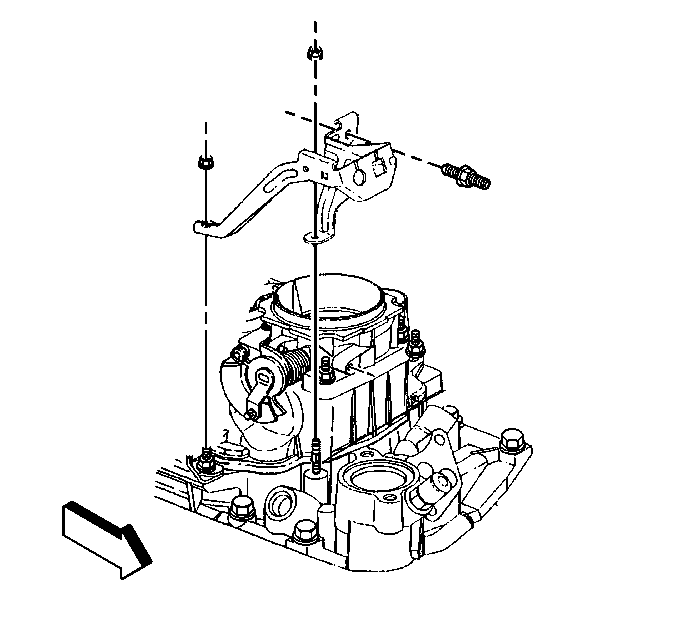
- Remove the accelerator control cable bracket
from the throttle body and the intake manifold.
- Remove the EVAP canister purge solenoid. Refer to
Evaporative Emission Canister Purge Solenoid Valve Replacement
in Engine Controls.
- Remove the fuel lines from the fuel meter body assembly. Refer to
Fuel Hose/Pipes Replacement - Engine Compartment
in
Engine Controls.
- Remove the distributor cap. Refer to
Distributor Replacement
in Engine Electrical.
- Remove the ignition control module. Refer to
Ignition Coil and Ignition Coil Module Replacement
in Engine Electrical.

- Remove the studs for the upper intake manifold.
- Remove the upper intake manifold.
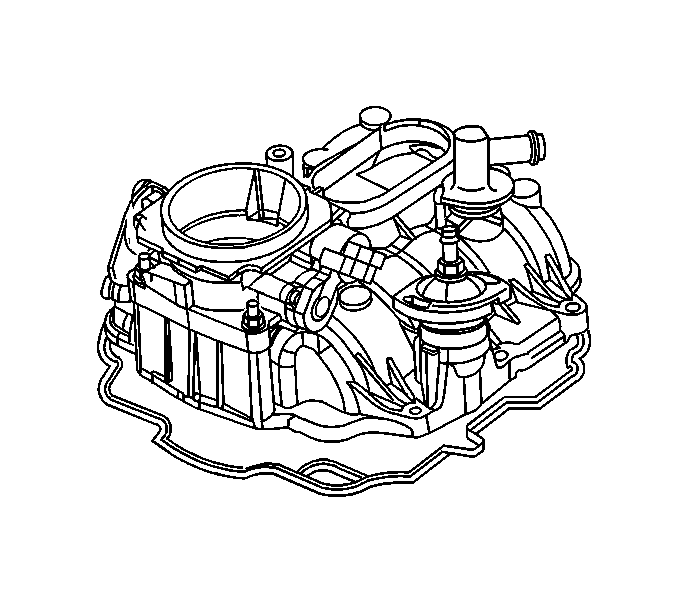
- Remove the upper intake manifold gasket
from the groove.
- Discard the gasket.
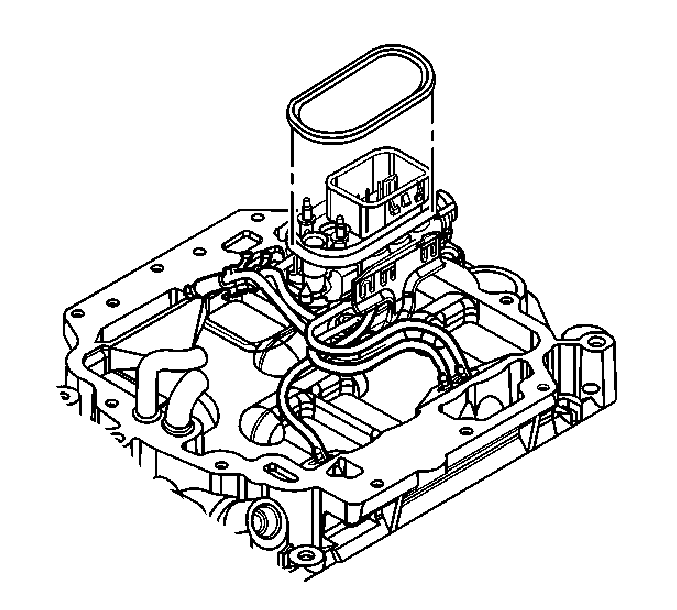
- Remove the seal from the fuel meter body
assembly.
- Discard the seal.
Important: Do not immerse the assembled upper intake
manifold in cleaning solvent.
- Clean all sealing surfaces and the inside of the upper intake manifold with
a shop towel and cleaning solvent.
- Inspect the upper intake manifold for the following:
| • | Cracks or other damage to the exterior |
| • | Cracking or damage to the gasket grooves |
| • | Loose or damaged bolt hole thread inserts |
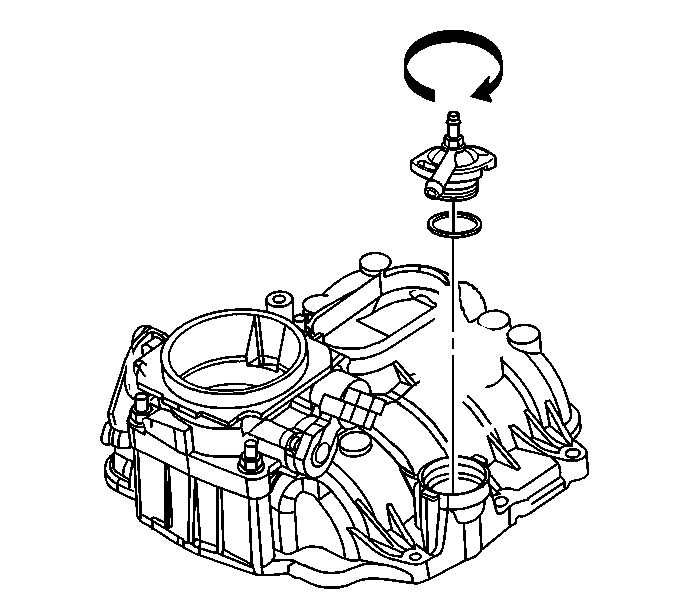
- If replacing the upper intake manifold,
turn and remove the power brake booster vacuum tube fitting from the upper
intake manifold.
- Remove and discard the seal.
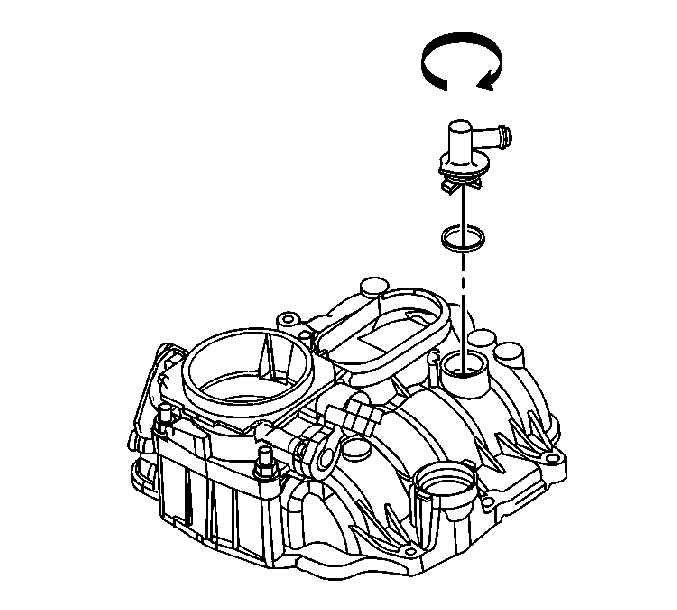
- If replacing the upper intake manifold,
turn and remove the PCV valve cover from the upper intake manifold.
- Remove and discard the seal.
- Remove the throttle body if replacing the upper intake manifold. Refer
to
Throttle Body Assembly Replacement
.
- Remove the MAP sensor if replacing the upper intake manifold. Refer to
Manifold Absolute Pressure Sensor Replacement
in Engine Controls.
Installation Procedure

- Install the throttle body, if removed.
Refer to
Throttle Body Assembly Replacement
.
- Install the MAP sensor, if removed. Refer to
Manifold Absolute Pressure Sensor Replacement
in Engine Controls.
- Install the PCV valve cover, if removed, using the following procedure:
| 3.1. | Install a NEW seal (O-ring) on the PCV valve cover. |
| 3.2. | Lubricate the seal with clean engine oil. |
| 3.3. | Install the PCV valve cover in the upper intake manifold. |
| 3.4. | Turn and lock the PCV valve cover in position. |

- Install the power brake booster vacuum
tube fitting, if removed, using the following procedure:
| 4.1. | Install a NEW seal (O-ring) on the power brake booster vacuum tube fitting. |
| 4.2. | Lubricate the seal with clean engine oil. |
| 4.3. | Install the power brake booster vacuum tube fitting in the upper intake
manifold. |
| 4.4. | Turn and lock the power brake booster vacuum tube fitting in position. |

- Install a NEW seal on the fuel meter body
assembly.
- Lubricate the seal with clean engine oil.

- Install a NEW upper intake manifold to
lower intake manifold gasket in the groove of the upper intake manifold.

- Install the upper intake manifold onto
the lower intake manifold.
- If reusing the fasteners, apply threadlock GM P/N 12345382
or equivalent to the threads of the upper intake manifold attaching bolts.
Notice: Use the correct fastener in the correct location. Replacement fasteners
must be the correct part number for that application. Fasteners requiring
replacement or fasteners requiring the use of thread locking compound or sealant
are identified in the service procedure. Do not use paints, lubricants, or
corrosion inhibitors on fasteners or fastener joint surfaces unless specified.
These coatings affect fastener torque and joint clamping force and may damage
the fastener. Use the correct tightening sequence and specifications when
installing fasteners in order to avoid damage to parts and systems.
- Install the upper intake manifold attaching studs.
Tighten
- Tighten the upper intake manifold attaching studs on the first pass to
5 N·m (44 lb in).
- Tighten the upper intake manifold attaching studs on the final pass to
9 N·m (80 lb in).
- Install the fuel lines to the fuel meter body assembly. Refer to
Fuel Hose/Pipes Replacement - Engine Compartment
in
Engine Controls.
- Install the distributor cap. Refer to
Distributor Replacement
in Engine Electrical.
- Install the ignition control module. Refer to
Ignition Coil and Ignition Coil Module Replacement
in Engine Electrical.
- Install the EVAP canister purge solenoid valve. Refer to
Evaporative Emission Canister Purge Solenoid Valve Replacement
in Engine Controls.

- Install the accelerator control cable bracket,
studs, and nuts to the intake manifold and the throttle body.
Tighten
Tighten the accelerator control cable bracket nuts
and studs to 12 N·m (106 lb in).

- Connect the A/C vacuum hose to the intake
manifold.
- Install the power brake booster vacuum hose bracket and nut to the intake
manifold stud.
Tighten
Tighten the power brake booster vacuum hose bracket
nut to 11 N·m (97 lb in).
- Connect the power brake booster vacuum hose to the intake manifold.

- Install the bracket for the engine wiring
harness on the lower intake manifold stud.
- Instal the engine wiring harness bracket nut.
Tighten
Tighten the engine wiring harness bracket nut to
12 N·m (106 lb in).

- Connect the following electrical connectors:
| • | The fuel meter body assembly connector (1) |
| • | The EVAP canister purge solenoid valve (2) |
| • | The manifold absolute pressure (MAP) sensor (3) |

- Connect the following electrical connectors:
| • | The throttle position (TP) sensor (1) |
| • | The idle air control (IAC) motor (2) |
| • | The engine coolant temperature (ECT) gauge sensor (3) |
| • | The A/C high pressure switch (4), if equipped |

- Connect the PCV valve hose assembly to the intake manifold and the valve rocker
arm cover.
- Install the cruise control cable, if equipped to the throttle shaft and
the accelerator control cable bracket. Refer to
Cruise Control Cable Replacement
in Cruise Control.
- Install the accelerator control cable to the throttle shaft and the accelerator
control cable bracket. Refer to
Accelerator Control Cable Replacement
in Engine Controls.
- Install the air cleaner outlet duct to the throttle body assembly. Refer
to
Air Cleaner Outlet Duct Replacement
in Engine Controls.
- Connect the PCV tube to the air cleaner outlet duct.
- Install the air cleaner. Refer to
Air Cleaner Assembly Replacement
in Engine Controls.
- Install the engine cover. Refer to
Engine Cover Replacement
in Interior Trim.
Intake Manifold Replacement Lower
Removal Procedure
Important: You do not have to remove the upper intake
manifold in order to remove the lower intake manifold.
- Disconnect the battery negative cable. Refer to
Battery Negative Cable Disconnection and Connection
in Engine Electrical.
- Remove the engine cover. Refer to
Engine Cover Replacement
in Interior Trim.
- Drain the cooling system. Refer to
Cooling System Draining and Filling
in Engine Cooling.
- Remove the air cleaner assembly. Refer to
Air Cleaner Assembly Replacement
in Engine Controls.
- Remove the air cleaner outlet duct from the throttle body assembly. Refer
to
Air Cleaner Outlet Duct Replacement
in Engine Controls.
- Disconnect the accelerator control cable from the throttle shaft and
the accelerator control cable bracket. Refer to
Accelerator Control Cable Replacement
in Engine Controls.
- Disconnect the cruise control cable, if equipped from the throttle shaft
and the accelerator control cable bracket. Refer to
Cruise Control Cable Replacement
in Cruise Control.

- Disconnect the PCV valve hose assembly from the intake manifold and the valve
rocker arm cover.

- Disconnect the following electrical connectors:
| • | The throttle position (TP) sensor (1) |
| • | The idle air control (IAC) motor (2) |
| • | The engine coolant temperature (ECT) gauge sensor (3) |
| • | The A/C high pressure switch (4), if equipped |

- Disconnect the following electrical connectors:
| • | The fuel meter body assembly connector (1) |
| • | The EVAP canister purge solenoid valve (2) |
| • | The manifold absolute pressure (MAP) sensor (3) |
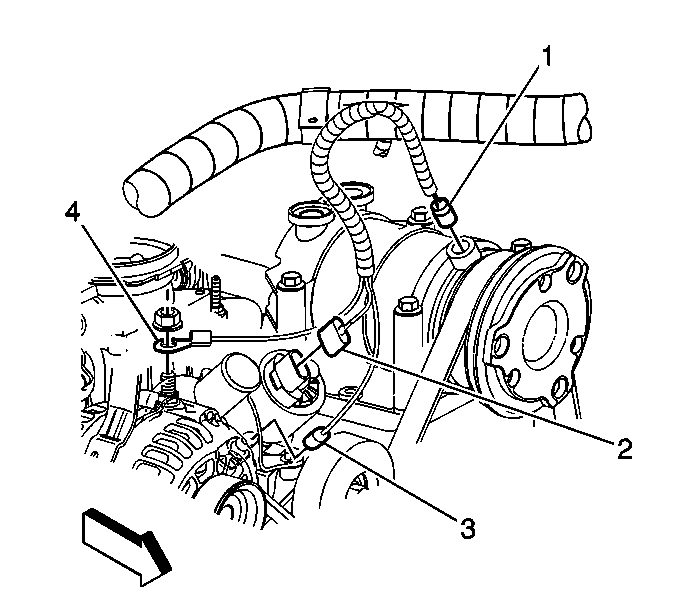
- Disconnect the following electrical connectors:
| • | The A/C compressor clutch (1), if equipped |
| • | The engine coolant temperature (ECT) sensor (3) |
- Remove the ground wire (4) from the stud at the water outlet.
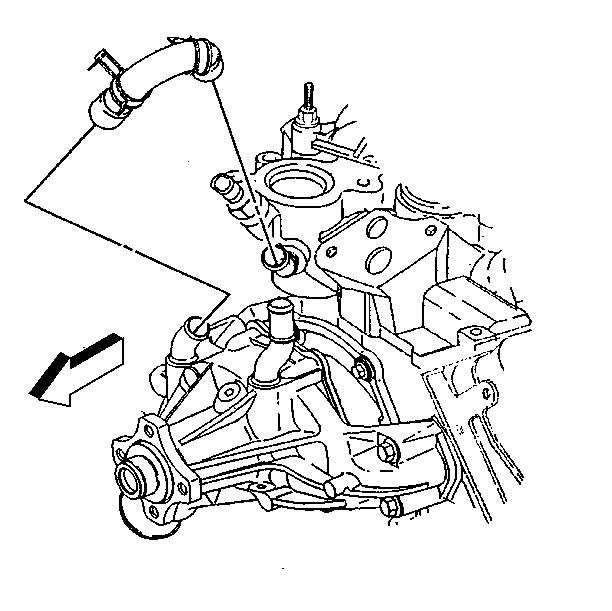
- Remove
the radiator inlet hose at the water outlet. Refer to
Radiator Hose Replacement
in Engine Cooling.
- Remove the heater hose from the intake manifold. Refer to
Heater Hoses Replacement
in Heating Ventilation and
Air Conditioning.
- Remove the water pump inlet hose from the intake manifold.

- Disconnect the A/C vacuum hose from the
intake manifold.
- Disconnect the power brake booster vacuum hose from the intake manifold.
- Remove the power brake booster vacuum hose bracket and nut.

- Remove the accelerator control cable bracket
from the throttle body and the intake manifold.
- Remove the EVAP canister purge solenoid valve. Refer to
Evaporative Emission Canister Purge Solenoid Valve Replacement
in Engine Controls.
- Remove the distributor. Refer to
Distributor Replacement
in Engine Electrical.
- Disconnect the fuel supply and the return pipes at the rear of the intake
manifold. Refer to
Fuel Hose/Pipes Replacement - Engine Compartment
in Engine Controls.
- Remove the ignition control module (ICM). Refer to
Ignition Coil and Ignition Coil Module Replacement
in Engine Electrical.
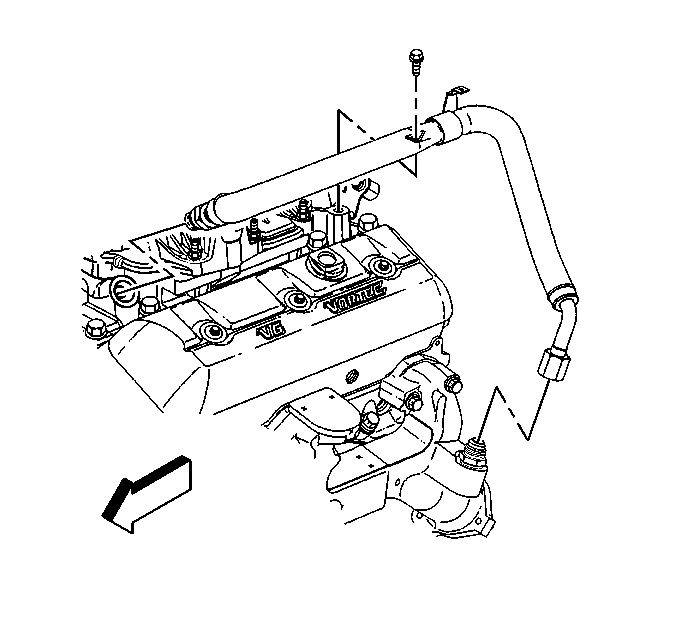
- Remove the spark plug wire harness retainer from the exhaust gas recirculation
(EGR) valve inlet pipe.
- Remove the clamp bolt for the EGR valve inlet pipe.
- Remove the EGR valve inlet pipe from the intake and the exhaust manifolds.

- In order to remove the front intake manifold
bolt, perform the following:
| 27.2. | Loosen the nut for the power steering pump rear bracket. |
| 27.3. | Remove the bolts and the nut for the power steering pump mounting bracket. |
| 27.4. | Leave the A/C compressor, if equipped, and the power steering pump on
the bracket. |
| 27.5. | Slide the power steering pump bracket forward to access the bolt at the
front of the intake manifold. |
- Remove the lower intake manifold. Refer to
Intake Manifold Removal
.
- Clean all sealing surfaces and the intake manifold. Refer to
Intake Manifold Cleaning and Inspection
.
- If the intake manifold requires replacement refer to
Intake Manifold Disassemble
and
Intake Manifold Assemble
.
Installation Procedure
- Install the lower intake manifold. Refer to Intake
Manifold Installation
.

- Reposition the power steering pump mounting
bracket.
Notice: Use the correct fastener in the correct location. Replacement fasteners
must be the correct part number for that application. Fasteners requiring
replacement or fasteners requiring the use of thread locking compound or sealant
are identified in the service procedure. Do not use paints, lubricants, or
corrosion inhibitors on fasteners or fastener joint surfaces unless specified.
These coatings affect fastener torque and joint clamping force and may damage
the fastener. Use the correct tightening sequence and specifications when
installing fasteners in order to avoid damage to parts and systems.
- Install the power steering pump mounting bracket three bolts and the nut.
Tighten
Tighten the power steering pump mounting bracket
bolts and the nut and the power steering pump rear bracket nut to 41 N·m
(30 lb ft).
- Install the drive belt. Refer to.
Drive Belt Replacement
.
- Install the exhaust gas recirculation (EGR) valve inlet pipe to the intake
and the exhaust manifolds. Refer to
Exhaust Gas Recirculation Pipe Replacement
in Engine Controls.
- Install the EVAP canister purge solenoid valve. Refer to
Evaporative Emission Canister Purge Solenoid Valve Replacement
in Engine Controls.
- Install the fuel supply and return pipes to the rear of the intake manifold.
Refer to
Fuel Hose/Pipes Replacement - Engine Compartment
in Engine Controls.

Important: In order to install the distributor for the
correct engine timing, position the engine to number one cylinder top dead center.
- Remove the spark plug for number one cylinder.
- Rotate the crankshaft until number one cylinder is in the compression
stroke.
- Align the two reference marks on the crankshaft balancer (1) and (4)
with the two alignment marks (2) and (3) on the front cover.
- Install the spark plug. Refer to
Spark Plug Replacement
in Engine Electrical.
- Install the distributor. Refer to
Distributor Replacement
in Engine Electrical.
- Install the ICM. Refer to
Ignition Coil and Ignition Coil Module Replacement
in Engine Electrical.

- Install the accelerator control cable bracket,
studs, and nuts to the intake manifold and the throttle body.
Tighten
Tighten the accelerator control cable bracket nuts
and studs to 12 N·m (106 lb in).

- Install the power brake booster vacuum
hose bracket to the intake manifold stud.
Tighten
Tighten the bracket nut to 11 N·m
(97 lb in).
- Connect the power brake booster vacuum hose to the intake manifold.
- Install the A/C vacuum hose to the intake manifold.

- Install
the water pump inlet hose to the intake manifold.
- Install the heater hoses. Refer to
Heater Hoses Replacement
in Heating Ventilation and Air Conditioning.
- Install the radiator inlet hose to the water outlet. Refer to
Radiator Hose Replacement
in Engine Cooling.

- Connect the following electrical connectors:
| • | The throttle position (TP) sensor (1) |
| • | The idle air control (IAC) motor (2) |
| • | The engine coolant temperature (ECT) gauge sensor (3) |
| • | The A/C high pressure switch (4), if equipped |

- Connect the following electrical connectors:
| • | The fuel meter body assembly connector (1) |
| • | The EVAP canister purge solenoid valve (2) |
| • | The manifold absolute pressure (MAP) sensor (3) |

- Connect the following electrical connectors:
| • | The A/C compressor clutch (1), if equipped |
| • | The engine coolant temperature (ECT) sensor (3) |
- Install the ground wire (4) and the nut to the water outlet stud.
Tighten
Tighten the ground wire nut to 10 N·m
(88 lb in).

- Install the PCV valve hose assembly to the intake manifold and the valve rocker
arm cover.
- Install the cruise control cable, if equipped to the throttle shaft and
the accelerator control cable bracket. Refer to
Cruise Control Cable Replacement
in Cruise Control.
- Install the accelerator control cable to the throttle shaft and the accelerator
control cable bracket. Refer to
Accelerator Control Cable Replacement
in Engine Controls.
- Refill the cooling system. Refer to
Cooling System Draining and Filling
in Engine Cooling.
- Install air cleaner outlet duct to the throttle body. Refer to
Air Cleaner Outlet Duct Replacement
in Engine Controls.
- Install the air cleaner assembly. Refer to
Air Cleaner Assembly Replacement
in Engine Controls.
- Connect the battery negative cable. Refer to
Battery Negative Cable Disconnection and Connection
in Engine Electrical.
- Install the engine cover. Refer to
Engine Cover Replacement
in Interior Trim.









































